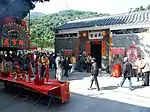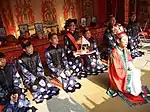

| Part of a series on |
| Taoism |
|---|
 |
Taoism is an East Asian religion founded in ancient China with many schools or denominations, of which none occupies a position of orthodoxy and co-existed peacefully.[1] Taoist branches usually build their identity around a set of scriptures, that are manuals of ritual practices.[2] Scriptures are considered "breathwork", that is "configurations of energy" (qi), embodiments of "celestial patterns" (tianwen),[3] or "revelations of structures" (li).[4]
The earliest Taoist schools emerged during the late Eastern Han dynasty (25-220 CE).[5] They blossomed especially in the region of Shu, modern-day Sichuan.[6] From the 12th and 13th centuries onwards several smaller branches merged into larger ones, but in turn, side-schools developed around the large traditions.[7] In modern times the existing schools tend to be classified under few overarching headings, in most cases under two main denominations: Quanzhen Taoism and Zhengyi Taoism.
Chronology of major schools[8]
Eastern Han period (25–220) to Tang period (618-907): development of the Taiping, Celestial Masters and Zhengyi schools.
- Wudoumi Taoism (五斗米道 Wǔdǒumǐ dào, "Way of the Five Pecks of Rice")
- Tianshi Taoism (天师道 Tiānshī dào, "Way of the Celestial Masters")
- Zhengyi Taoism (正一道 Zhèngyī dào, "Way of the Right Oneness")
- Tianshi Taoism (天师道 Tiānshī dào, "Way of the Celestial Masters")
- Taiping Taoism (太平道 Tàipíng dào, "Way of the Great Peace")
Eastern Jin period (317–420) and Southern dynasties period (420-589): development of the Shangqing and Lingbao branches.
- Shangqing Taoism (上清派 Shàngqīng pài, "School of the Highest Clarity")
- Maoshan Taoism (茅山宗 Máoshān zōng, "Maoshan Lineage" or "Maoshan Church")
- Lingbao Taoism (靈寳派 Língbǎo pài, "School of the Numinous Treasure")
- Louguan Taoism (樓觀派 Lóuguān pài or 樓觀道 Lóuguān dào, "School [or Way] of the Contemplation Place")
Jurchen Jin period (1115–1234): development of the Quanzhen branch.
- Quanzhen Taoism (全真道 Quánzhēn dào, "Way of the Fulfilled Virtue")
- Zhenda Taoism (真大道 Zhēndà dào, "True Wide Way")
- Taiyi Taoism (太一道 Tàiyī dào, "Way of the Great Oneness")
Southern Song period (1127–1279): Tianxin, Shenxiao, Qingwei, Donghua and Jingming branches.
- Tianxin Taoism (天心派 Tiānxīn pài, "School of the Heavenly Heart")
- Shenxiao Taoism (神霄派 Shénxiāo pài, "School of the Divine Empyrean")
- Qingwei Taoism (清微派 Qīngwēi pài, "School of the Pristine Simplicity")
- Donghua Taoism (東華派 Dōnghuá pài, "School of the Eastern Flower")
- Jingming Taoism (淨明道 Jìngmíng dào, "Way of the Pure Light")
16th and 17th centuries: Wuliu.
- Wuliu Taoism (伍柳派 Wŭliŭpài, "School of Wu-Liu")
Other schools[9]
- Bojia Taoism (帛家道 Bójiā dào)
- Lijia Taoism (李家道 Lǐjiā dào, "Way of the Li Family")
- Longhu Church or Lineage (龍虎宗 Lónghǔ zōng)
- Gezao Church or Lineage (閣皂宗 Gézào zōng)
- Jindan Taoism (金丹派 Jīndān pài) or Southern Church (南宗 Nán zōng)
- Beidi Taoism (北帝派 Běidì pài)
- Laoshan or Lao Huashan Taoism (老華山派 Lǎo huàshān pài)
- Jiu Gongshan Taoism (九宮山派 Jiǔ gōngshān pài)
- Xuan Taoism (玄教 Xuán jiào)
- Longmen Taoism (龍門派 Lóngmén pài)
- Namo Taoism (南無派 Námó pài)
- Suishan Taoism (隨山派 Suíshān pài)
- Yuxian Taoism (遇仙派 Yùxian pài)
- Yushan Taoism (嵛山派 Yúshān pài)
- Qingjing Taoism (清靜派 Qīngjìng pài)
- Sanfeng Taoism (三豐派 Sānfēng pài)
- Wudang Taoism (武當道 Wǔdāng dào) or Wudang Benshan Taoism (武當本山派 Wǔdāng běnshān pài)
- Jinshan Taoism (金山派 Jīnshān pài) or Laoshan Taoism (嶗山派 Láoshān pài)
- ChunYang Taoism (纯阳派 chunyang pài)
Newest schools:
- Dong Taoism or Eastern Taoism (東派 Dōng pài), Neidan Dong Taoism (内丹東派 Nèidān dōng pài)
- Xi Taoism or Western Taoism (西派 Xi pài), Neidan Xi Taoism (内丹西派 Nèidān xi pài)
